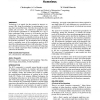Free Online Productivity Tools
i2Speak
i2Symbol
i2OCR
iTex2Img
iWeb2Print
iWeb2Shot
i2Type
iPdf2Split
iPdf2Merge
i2Bopomofo
i2Arabic
i2Style
i2Image
i2PDF
iLatex2Rtf
Sci2ools
CHI
2008
ACM
2008
ACM
Designs on dignity: perceptions of technology among the homeless
Technology, it is argued, has the potential to improve everyone's life: from the workplace, to entertainment, to easing chores around the home. But what of people who have neither job nor home? We undertook a qualitative study of the homeless population in a metropolitan U.S. city to better understand what it means to be homeless and how technology--from cell phones to bus passes--affects their daily lives. The themes we identify provide an array of opportunities for technological interventions that can empower the homeless population. Our investigation also reveals the need to reexamine some of the assumptions made in HCI about the relationship people have with technology. We suggest a broader awareness of the social context of technology use as a critical component when considering design innovation for the homeless. ACM Classification Keywords K.4.2 Social Issues: Miscellaneous Author Keywords Homeless, Urban Computing, Social Computing, Value Sensitive Design, Diary Study, At...
ACM Classification Keywords | CHI 2008 | Homeless Population | Human Computer Interaction | Miscellaneous Author Keywords |
Related Content
| Added | 30 Nov 2009 |
| Updated | 30 Nov 2009 |
| Type | Conference |
| Year | 2008 |
| Where | CHI |
| Authors | Christopher A. Le Dantec, W. Keith Edwards |
Comments (0)

